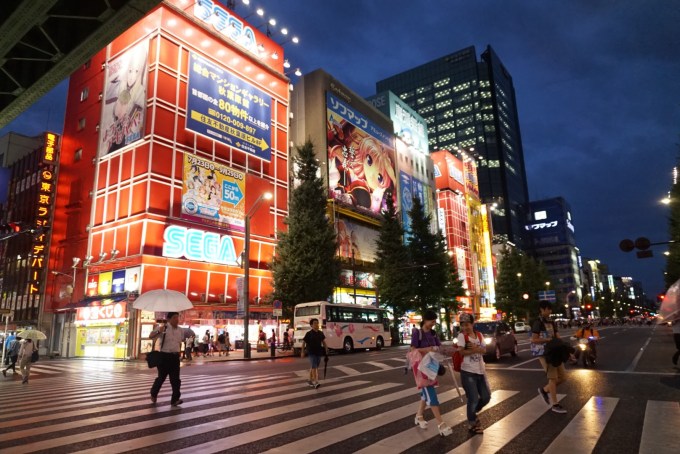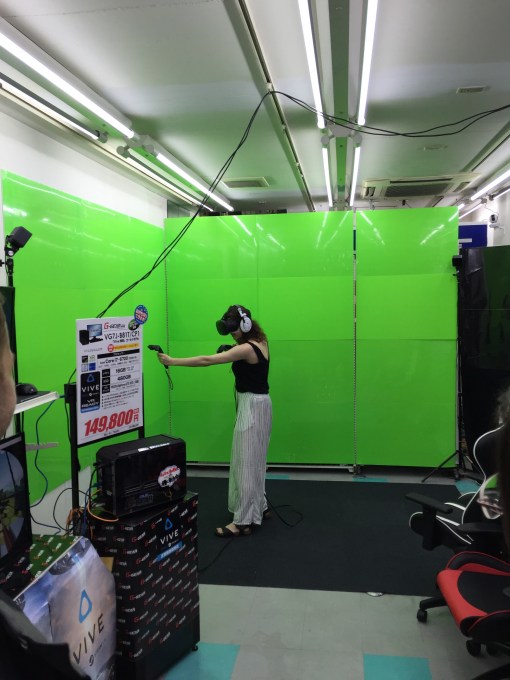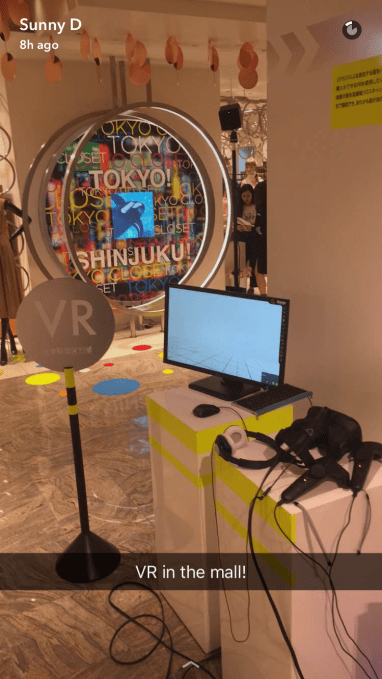I spent a week in Tokyo last month as a speaker at the CEDEC gaming conference. Had you asked 10 year old me about Japan, I would have conjured up images of Godzilla, Dragon Ball Z, and ninjas. Funnily enough, day trips to Akihabara and Harajuku brought some of these to life through arcades, cosplayers, and stores full of manga collectibles. Walking around Tokyo, I saw virtual reality poised for blast off.
The legacy of arcade and console games is evident all over Tokyo. Walking through Akihabara, I saw a culture that praised gamers and geeks. Trendy hipsters played the games of my childhood: Altered Beast, Golden Axe, Bubble Bobble, Wonder Boy, Dynamite Dux, Streets of Rage…and, of course, Super Mario. For those who don’t know, Akihabara is an entire district of Tokyo solely dedicated to consumer electronics, tech, and arcade gaming. So…many…neon…lights!

Tokyo’s Akibahara gaming district
Akihabara, or wider Tokyo in general, has never had an abundance of internet cafes like China, nor a large PC gaming audience like in the West. Wifi and broadband enabled homes have negated the need for the former and consoles and arcades have done so with the latter.
Without a PC gaming culture, high end VR headsets don’t have a natural place in Japan. That said, the HTC Vive has emerged as a front runner in Japan’s fledgling experiential VRcades.

Spectators surround folks playing VR games in these VRcades and they’re able to watch the player through viewpoints other than the gamer’s first person view. VR gaming becomes very watchable for spectators in VRcades as a result of mixed reality filming.
Mixed reality filming (like that seen below) allows viewers to see what gamers see in VR, without having to watch through a ‘first person view’ (which can make folks nauseous and dizzy). It’s an innovative way to move a camera around the VR world and film gameplay for real world spectators. I think there will be arcade VR and living-room VR in Japan, but the far more real world, social experiences around VR gaming will come from the arcades, not the living room.
Furthermore, mixed reality theme parks are a ‘thing’ in Tokyo. Really worth checking out are Melbourne-based Zero Latency VR’s mixed reality zombie survival crossover with Sega Live Creations at the Yokohama Joypolis theme park or Bandai Namco’s VR Gundam Wing arcades in Odaiba. Both of these are great, but reportedly do not compare to the well funded darling of Western mixed reality, ‘The Void’. The Void was noticeably missing from Tokyo’s VR landscape, despite its theme-park-like success in New York’s Time Square with the Ghostbusters IP (where they charge gamers $50 per 8 min ‘ride’).
Japanese living room gaming has been dominated by Nintendo and Sony for decades. While Nintendo has been silent on VR to date, Sony’s Playstation VR headset will be very popular in its homeland. While PSVR’s positional tracking solution or hardware specs aren’t quite as good as the Vive’s, it does not require a cleared, separate room for operation, nor a powerful PC to run. I expect that Sony’s branded homeland strength, its robust pre-installed Playstation user base, and its deep understanding of AAA game development position PSVR for success in Japan.
 Outside of gaming, VR’s presence in retail is evident too. At Shinjuku’s high end department store, Isetan, I saw 2 separate designers using VR shopping experiences. These were part immersive advertising (with trippy art/fashion shows), and part commerce (for exploring new season inventory).
Outside of gaming, VR’s presence in retail is evident too. At Shinjuku’s high end department store, Isetan, I saw 2 separate designers using VR shopping experiences. These were part immersive advertising (with trippy art/fashion shows), and part commerce (for exploring new season inventory).
It was interesting that these mall installations didn’t have technicians on hand to shepherd folks through the VR experience as is the case in a US Best Buy store, for example. Instead, shoppers were expected to pick up the displayed Vive headset and start cycling through fashion content without explanation.
Finally, I can’t talk about Japan and NOT talk about augmented reality. Over the last year smartphone augmented reality facial filters were the hot ticket; Snapchat obsessed over Looksery and Facebook went soft in the knees for MSQRD, with each paying a rumored ~$70m and ~$150m to acquire each, respectively.
With smartphone AR becoming the norm in America, I was surprised to see that AR photo booths were such a big deal in Tokyo. Not just that, but there were long lines for each booth.
Patrons had separate areas for putting on makeup, which I didn’t really understand, as the AR ‘beautification filters’ kind of made any prior prep irrelevant.
I could show up looking scruffy and the part glamour-shot, part ‘Hello Kitty / Barbie doll’ filters would fix everything. To see what I mean, Google me to see what I look like regularly…it’s not like this:

Continuing on AR for a minute, Line’s messaging app has smartphone market leadership in Japan and it’s fairly light on computer vision entertainment applications. The filtered wizardry of apps such as Prisma and Artisto will become globally commonplace as will the face masks mentioned above from MSQRD and Looksery.
These are presently missing from Line. So, I wonder if these filters’ rising success in Japan will diminish the popularity of AR photobooths, though I’d predict going out to take selfies with friends is about the social experience as much as it is the end result, so perhaps the booths are part of Japan’s AR future.
Pending the (likely) success of Playstation VR, Japan’s domestic VR market is going to be huge. Japanese VR startups such as Fove have raised $11m to date and it counts Softbank’s Taizo Son among its investors. Fove has been a pioneer in eye tracking and its CEO, Yuka, has become a literal poster child for Japanese VR (see Forbes Magazine). Japan’s home turf VR investors include Gumi, GREE, and Colopl, the latter of which has already made ~30 investments to date.
Everything is in place for Tokyo to become a true global VR hub and it was a privilege to visit at ground zero this past week. Playstation VR will kickstart living room VR and social VRcades will become an extension of Japan’s arcade culture today. I can’t wait to go back and write another VRticle.